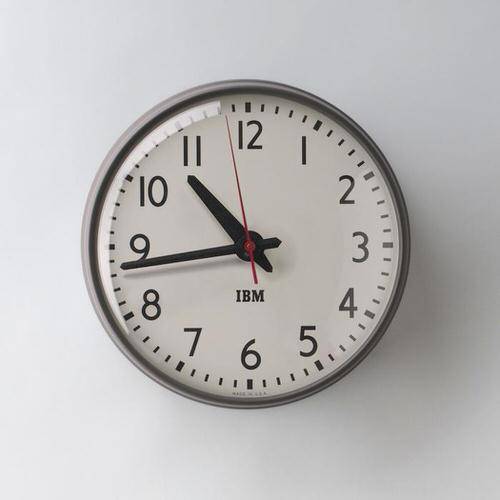
This post was originally published on our SAY Media sister site, Remodelista. We’re republishing it with permission.

Frank Lloyd Wright said it best: “If it keeps up, man will atrophy all his limbs but the push-button finger.” Technology permeates every corner of our universe: our homes, our cars, our sidewalk strolls, even our free time. Like any healthy relationship, our daily interaction with technology (particularly with our handheld devices) should be guided by moderation and balance. If we approach technology use mindfully, we can be more productive, think more clearly, and best of all—we can feel happier doing it. Here are my ten secrets to managing technology:

Above: Schoolhouse Electric’s faithful reproduction of the 1960s IBM Standard Issue Clock ($235) harks back to simpler times.
1. Take an inventory. Have you ever looked up at the end of the day and gasped, “Where did the time go?” Well—where did it? Jot down notes about how, when, and for how long you use technology. Be specific: How many minutes do you spend responding to email? Do you check your Twitter feed before coffee? (Be honest.) Our digital availability can be a notorious time suck. Apps like Toggl, which tracks time spent online, and Anti-Social, which will temporarily disable your social networks, can help. Here is a killer review on Toggl.
2. Notice the internal sensations you experience. As you click and tap away, are your neck muscles tightening? How is your breathing? You don’t need to wait until evening couch o’clock to relax. As you work, you can simultaneously unclench the jaw, soften the shoulders, and deepen the breath. (We modern humans tend to focus on external stimuli, but studies show that attention to the internal improves well-being.) I put stickers on my cell phone and laptop to remind me.
3. Take regular tech breaks and do things the old-fashioned way when possible. Write to-do lists using pen and paper; keep a spiral journal for ideas (we love Postalco Notebooks from Japan, available in a range of sizes and colors from Canoe). Within reason, print things out for reading to spare your eyes from over stimulation. Leave your office for lunch each day and allow yourself at least a 50-minute break: take a walk, sit in the grass, and let your brain unwind. Every one to two hours, do something that calms the brain: listen to music, call a friend, or spend time in nature. Change your attitude to accept that you can be productive away from the computer. (Research shows that too much time online creates an ongoing state of anxiety called technostress.) Breakthroughs rarely occur while hunched over a phone sending superfluous texts, anyway.

4. Make your waiting a time to brainstorm, think, and reflect. Use this time to think deeply: What do you want in life? Are you taking the right steps to get there? P. M. Forni, a professor at Johns Hopkins University and author of The Thinking Life: How to Thrive in the Age of Distraction ($10.39 at Amazon), advises us to “rediscover and embrace serious thinking as a defense against a culture of distraction.” Review the major decisions you have made today: Do you need to refine any? (When your latte arrives, you’ll feel better and be on the road to a more productive and insightful day.) These Fort Standard Balancing Blocks ($48 from Areaware) might remind you to take time to be creative and play.


5. Let your day be purposeful; Do one thing at a time. Research has shown we are not well-suited for multi-tasking. Set a timer (I recommend the i-Qi, which features Zen chimes and singing bowls) when using social media or anything that has a tendency to suck you in. Set an intention each morning such as “Take Regular Mindful Minutes” and write it down where you will see it. We can (and should) choose to become more discerning, and to direct our attention more purposefully. Rather than being reactive to the onslaught of messages, texts, alerts, and reminders, we can reclaim the driver’s seat: We can decide not to be interrupted. (Apps like Self-Control for Macs and Freedom for PCs can help.)
6. Slow down and concentrate. We live in a world that is compelled to do more faster, but in the interest of health, happiness, and well-being, we should take our time. When I type at a slower pace, or scroll through my messages with special care, even the most “stressful” chores can be done with greater ease. (If you can master this, work itself can become a time to be present, to be fully engaged, and therefore, enjoyable.) Concentration—a prescription for an anti-frazzled modern life—is like a muscle: the more you exercise it, the stronger it becomes. If you need help, Concentrate will block distracting sites and send you reminders to stay on task.
7. Make your devices less stimulating. Your day is punctuated by a chorus of beeps, blings, and flashing lights that are jarring to the nervous system. Choose pleasant notification options. Change your ringer to a gentle sound. Turn the screen brightness down a notch (especially in the evening). Consider using a pair of noise-canceling headphones while getting focused; I recommend the Bose QuietComfort. Clean up your desktop (delete or file icons that clutter the screen) and remove any unnecessary apps from your phone. I recommend deleting social media apps from your phone unless you truly need them on the go. Let the phone return to its primary use: making calls.

8. Break the cycle of being available 24/7. Our blurred online/offline lives have made us reactive rather than proactive. Ask yourself: “Do I really need to be available right now?” A firm “no” is a form of self-respect. Turn off your cell phone when you are not actively using it. (This is one of the best life changes I’ve made; one that has greatly reduced stress and unnecessary interruptions.) Daydreaming, boredom, and introspection are an important part of life, especially a creative life. Don’t sleep with your phone in your bedroom, and consider setting a tech curfew a couple hours before bed—two of our sleep secrets. Make a commitment to only check email at a handful of regular times throughout the day.
9. Be fully engaged in whatever you are doing. “We never live,” Voltaire famously lamented, “we live in anticipation of living.” When we are fully engaged in a task, we experience something psychologist Tory Higgins refers to as “flow,” a presence of mind that boosts mood and allows us to extract value from whatever it is that we are doing (even if it is filing that dreaded invoice). I love the saying, “if you can’t get out of it, get into it.” (I picked this up from Gretchen Rubin’s best-selling book, The Happiness Project; $9 at Amazon.) Resistance creates anxiety: when what we want to be doing and what we are doing meet, we can experience a state of well-being. Get out of your head and get into your body: Feel your fingertips touch the keyboard, notice your feet on the floor, feel your breath.

10. Pause before you respond. We’ve lost an important thing in our supersonic-paced lives: the quiet space of the pause. “Life might be a race against time, but it is enriched when we rise above our instincts and stop the clock to process and understand what we are doing and why,” investment banker turned writer Frank Partnoy points out. As Partnoy, the author of Wait: The Art and Science of Delay ($15.83 at Amazon), says, “a wise decision requires reflection, and reflection requires pause.” Ask yourself: “Do I need to respond to this right now?” Fill your day with regular pauses, as those quiet spaces will provide insightful moments that steer you where you really want to go.
N.B. Suffering from technostress? What are your strategies for unplugging and unwinding? (And when it’s time to power down and turn in, consult 10 Secrets for a Better Night’s Sleep).
Related Remodelista posts:





















